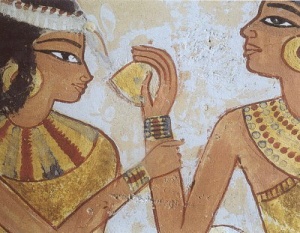At this present moment, our home is filled with flowers. Yes, I know. It’s February. That’s why it’s filled with flowers. And since oriental lilies are some of our favorites, right now, I’m smelling the sweet-dark scent of those wonderful lilies throughout the living room.
And all this leads me to think of the perfumes of ancient Egypt and, of course, the perfumes of Isis particularly. For the Goddesses and Gods of Egypt were always associated with scent. Beautiful scents have always been connected with the Divine, but in Egypt particularly, you knew that a Deity had arrived when you smelled Her or His perfume in the temple air.
The Egyptians apparently blended scents appropriate for their Deities; for instance, there is a record of an unguent called “Aroma of Horus.” Surely, there was an “Aroma of Isis,” too, but alas, we have no record of it to date. Today’s magical perfumers, on the other hand, almost always have a scent for Her. Isis’ association with scent remained part of Her manifestation even after Her worship spread beyond Egypt. In Apuleius’ account of initiation into the Mysteries of Isis, his protagonist sees Isis in a vision and remarks that She breathed forth the “blessed fragrance of Arabia.”
My personal favorite scent for Isis is stargazer lily. With its deep pink, engorged-looking blossoms, stargazers are downright sexual in their showiness. Of course that is exactly what any flower is; sexual. As you may know, flowers are the sex organs of plants, which they display for all the world to see, marvel at, and enjoy. No wonder we have always given flowers as a love gift.
I like the blatant, vulva-pink sexual display of the stargazer to be sure. And the flower’s name reminds me of Isis’ own starry connections. But the main reason I associate them with Isis, and give them in offering to Her, is the scent. The stargazer’s soft, sweet perfume is deepened with a dark, funky musk that is almost animal-like in its pungency. The stargazer is my “jitterbug perfume.” (If you have not read Tom Robbin’s Jitterbug Perfume, oh please do!) The mixture of sweet and strange all wrapped up in an audacious package seems to me a perfect floral resumé for Isis. She offers us the sweet love of a mother one moment, then freaks us out completely with some weirdly magical happening the next. Like the flower, She is not shy; never shy. She will always tell you what you need to hear even when you don’t particularly want to hear it. Thus do I offer unto Isis that which is Hers: the beautiful stargazer lily.
The ancient Egyptians had no stargazers, alas. But they did associate a variety of other scents with Isis as well as with other Deities.
Expeditions to Punt for cinnamon, frankincense, myrrh, and other precious resins, were common throughout Egyptian history. The huge gardens attached to the temple complexes also supplied vast quantities of herbs and flowers for the creation of the gallons of scent, pounds of incense, and thousands of bouquets offered in Egyptian temples. Many temples, such as those at Edfu and Denderah, even had special laboratories for making perfume and incense. Perfume was, after all, one of Egypt’s most lucrative exports.
Cleopatra VII, the queen who styled herself “the New Isis,” was reputed to use a different perfume for every part of her body and was credited with writing a book on the subject. But Cleo’s perfumes would not have been the clear, alcohol-based liquids we think of as perfume today. Egyptian perfumes were oil and fat-based; similar to our solid perfumes that liquefy as they are rubbed into the skin. A number of Egyptian perfumes were quite famous, the name brands of their day.
Lily was the dominant scent in Susinon, a perfume that seems to have been made exclusively by women. Perhaps this was because the lily was connected with female sensuality and spirituality and lily oil was a common treatment for “female complaints.” Lotus oil, from the sacred blue lotus (actually a blue water lily), was a favorite essential oil and associated with rebirth. It was the fragrance most favored by Egyptian priestesses. Other Egyptian perfumes include Magaleion, a complicated, difficult-to-make scent; Mendesian, known simply as “The Egyptian,” which was a spicy, resinous perfume; Metopion, a mixture of resins, herbs, sweet wine, and honey; and Sampsuchum, a marjoram-based scent sweetened with herbs and nasturtium flowers.
And then there was Kyphi, both an incense and perfume.
Recipes for Kyphi perfume are engraved on the walls of the temple of Isis’ son, Horus, at Edfu and at Philae, Isis’ own great temple in Upper Egypt. Kyphi was used especially to welcome the Deities to Their temples. Wine-based, Kyphi also includes sweet flag, rushes, cinnamon, juniper, raisins, myrrh, frankincense, cardamom, and gum mastic. In his essay “On Isis and Osiris,” Plutarch reports 16 ingredients and says that Kyphi calms, soothes, and can lull to sleep. It is also said to sharpen the intuition and promote dreams.
A priestess friend and I once made a ridiculously huge batch of Kyphi from Plutarch’s recipe, bits of which I am still burning to this day. It has a warm smell; like spicy raisin cookies. In fact, you could eat it without harm—and I believe the Egyptians did, medicinally. Luckily for me, it seems to get better with age.
What scents do you associate with Isis? There are no wrong answers. This is a personal thing. I’d love to hear your thoughts in the comments.







